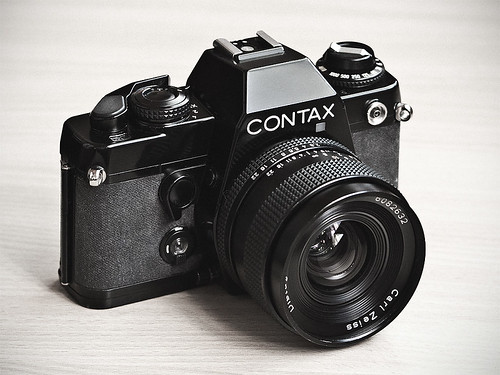Contax 139

|
| The Contax 139 Quartz with a 35mm f2.8 Carl Zeiss lens image by gorkola (Image rights) |
The Contax 139 Quartz is a 35mm SLR that was introduced in 1979 and manufactured up until 1987 with something over 200,000 being built in that time. It was manufactured by Yashica in Japan under licence to Zeiss. Yashica also manufactured the Yashica FX-D which was seen as a budget version of the 139 with less features but, in fact, was largely a completely different camera.
The 139Q had a quartz-timed, electronically-controlled vertical metal shutter that was very advanced for its day. It has speeds of 11 seconds to 1/1000 of a sec in auto, and 1 to 1/1000 in manual exposure mode.
The metering system is a center-weighted system with a range of 0 to 18 EV(f/1.4) using a silicon photo diode cell. The through-the-lens TTL synchronized flash with the TLA20 and TLA30 flash units. Other new features included manual or aperture-priority exposure controls and a DOF preview lever. An AE lock feature available to hold metered shutter speeds, and an improved flash sync speed (1/100th sec.). Exposure compensation is available and can be adjusted by over or under 2 EV.
The finder has a matte field with a horizontal split-image device surrounded by a microprism. The aperture information is on the top of the finder. Full exposure information visible in the viewfinder with individual shutter speeds on the right lit by LED. It is powered by two SR44 batteries.
An optional winder, powered by four AA batteries, was available for the camera.
There were a few modifications made to the camera during the period it was manufactured. These were, at least in part, to overcome some reliability issues with early examples. The most common problem with the 139 is a sticking release magnet. The electronic shutter release causes an electrical pulse to be sent to the release magnet. The release magnet is a combination magnet that holds the mechanism in its cocked position using a permanent magnet. The electrical pulse energises an electromagnet which is in opposition to the permanent magnet and so cancels the magnetic field so releasing the mechanism. Over time, the face of the magnet becomes fouled and the armature becomes stuck to it so fails to move away when the magnetic field is turned off. In later models, the magnet and associated mechanism were improved which largely eliminated the problem.
Another change that took place was to the transfer switch. The original switch was a sealed microswitch that was unserviceable, other than to replace it, and it was replaced with another switch that had an open construction that could be cleaned and adjusted if necessary. Another change replaced the switch with a simpler mechanism that had less parts and needed no adjustment. Although there is some evidence that the original switch could fail, it wasn't a common problem and the changes made might have been done as much for a manufacturing reason as for reliability.
There is no known serial number data for the 139 but available information shows the magnet problem was corrected in cameras with serial numbers above, approximately, 110,000. The original transfer switch was replaced around the same time as the magnet change and then changed again around serial number 150,000.
In total there was something over 200,000 units made and just a handful of cameras with serial numbers above 200,000 have been seen. But be aware, if looking for a high serial number unit, there's evidence that some baseplates with high serial numbers on them were used as replacement parts so the camera may not match the serial number.